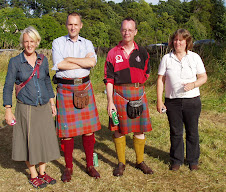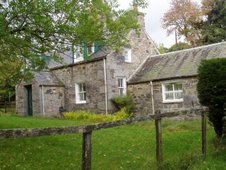It was a rather fraught day. Fair Isle knitting does not
consort well with constant interruption. Still, I got another border pattern
done. I don’t care for it much. You’ll see, soon.
All this talk of the J&S-Shetland-Museum sweater – the
one you knit, MaureeninFargo, although I hadn’t grasped that until today – has
made me wonder whether I should try to see what can be made of that, using my
colours. I’m pretty sure it would be easy to chart it, using the illustration
in Mucklestone’s book and the ones posted by Maureen and the one other Raveller
who has attempted it.
I think maybe that will be the next experiment for my
swatch-scarf. Only one lozenge-pattern per row, of course, and perhaps even a
different peerie.
There’s a passage in Meg’s introduction to her Fair Isle
cardigan in “Knitting” which baffles me. Maybe you can help. She is writing
about the problem of what to do with a Fair Isle, knit bottom-up, when you get
to the armholes. Work back and forth, which will involve purling? Or steek, and
go on knitting in the round? Both solutions are found on Shetland, she says.
Then this: “Designers Lizbeth Upitis and Joyce Williams knit
forwards and backwards from the underarm up – no steeks, no cutting, no purling
back in pattern.”
What does that mean? The only Third Way I can think of is to
cut the yarn at the end of every row and push everything back to the other end
of the needle. That is indeed possible, but I wouldn’t describe it as “knitting
forwards and backwards”.
Here’s my husband’s Tannehill, dark line and all:
In my wanderings last night, I wound up on Jimmy Bean’s
madtosh DK page. I haven’t been there for quite a while. A great many of the
colours were unfamiliar, and goodness! how wonderful! No wonder Tannehill went
under, if they bring out new colours at that rate. It occurred to me to wonder whether
the pattern for my leftovers, perhaps supplemented by one or two skeins of
new-and-wonderful colours, might be this, which you’ve seen before:
It is written for 4-ply (sport weight, that would be, I think, more or less) in one size only. But it might not
even have to be converted, as that one size is distinctly petite. Maybe in DK,
it would come out about right. If conversion is necessary, I don’t think it
would be too difficult.
Now I must go and put the clocks forward, and put some cider
on ice for tomorrow….






Knit Back Backwards. That's how you work back and forth without turning your work. It is a bit fiddly at first but it develops its own rhythm. Try it first with one color, looking at your hands in a mirror. There must be YouTube videos, too. I'm using it for intarsia, much easier to work than purling with multiple colors.
ReplyDeleteGood luck!
Enjoy your cider tomorrow. I need to buy some, myself!
The Tannehill is growing by leaps, it looks cozy.
These vintage patterns are fab indeed!
ReplyDeleteI hope Mungo has returned home safely and had some good experiences in Beirut.
Enjoy the well-earned cider!
LisaRR
I think what Meg is talking about is what I called knitting backwards when I "invented" it, age 7. You don't turn your work. When you reach the end of the row, you knit left-handed back across the row. That way, you are always looking at the front of the pattern, and don't have the difficulty of trying to follow the pattern on a purl row.
ReplyDeleteIn my case, age 7, I was working on a bulky sweater on 12" needles, and every time I turned the knitting around, I dropped stitches off the end (I don't know if they had circular needles in 1956; I know we didn't have them). In frustration, I stopped turning the work, and just knit right- and left-handed. No more dropped stitches, and my aunts were very impressed!
Knit left handed on the return rows. It's fiddly though and your tension may change. What's wrong with simply purling them?
ReplyDeleteThis comment has been removed by the author.
ReplyDeleteToo oate fir this swearpter, but maybe ofr the next time, choose the skeins that match the best for the main body of the sweater, and use the odd ones for the ribbing, neckband, armhole bans?
ReplyDeleteBeverly in NJ
Echoing the above entries about knitting back without turning. It's a technique that works really well for entrelac. I would steek it myself though for Fair Isle to keep the tension even.
ReplyDeleteI actually "talked" (via email) to Joyce Williams about this when she was writing "Latvian Knitting". There is an explanation on page 4 of the book if you have it. Yes, you are knitting back backwards.
ReplyDeleteSurely, on a simple Fair Isle pattern, the easiest thing to do would be to purl the wrong side rows? It mystifies me that steeking has gained such a hold in mainstream knitting.
ReplyDeleteAs many have already said, Knitting Back Backwards was what Meg was talking about. I've seen them all do it at Knitting Camp......some people will do anything to avoid purling, seriously! It is more convenient for short things like lace edging and entrelac where you would otherwise be constantly be turning your knitting. In Fair Isle I'd rather steek, in addition to keeping the knitting flowing around and around it gives me a convenient place to change colors without having to weave them in. As Meg always says, it's Knitter's Choice, and isn't it wonderful to have that choice?!
ReplyDeleteI find KBB challenging for my brain, never mind the tension. I'm fine with steeking. Yes, I hope your grandson is home safely. That mosiac was sweet.
ReplyDeleteI do see the line in your husband's new sweater, but it doesn't look out of place - there being scads of smatters of the same color through out the rest of the sweater. To me it looks like the winter solstice and the coming of spring. I hark back to my emotions of your own sweater with contrasting hues between body and arms and the joy of seeing the beauty of the finished sweater...you are a artist. So, I look forward to the finished product.
ReplyDeleteIn this pattern the 'contrast' colours are segregated and touch only the background colour. It does not allow the delightful colour combinations you can get eg in Fair Isle.
ReplyDeleteI find that I have a distinct preference for the previous pattern. IMHO, I feel it would lend itself better to the pleasing juxtaposition of the colours you already have, with the addition of any yarn necessary to make up the necessary quantity and /or contrasts. Bearing in mind that you may include as many or as few diagonals as you like.
Of course I recognise that it is your knitting and entirely your choice, I just look forward to when you can share the outcome. :-)
Helen (anon)
i love KBB...use it for sock heels (cant stand turning) and yes i HATE purling.. my tension is different but with KBB my tension is the same.
ReplyDelete